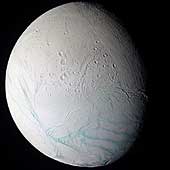|
COMETS EARTH JUPITER KUIPER BELT MARS MERCURY METEORITES NEPTUNE OORT CLOUD PLUTO SATURN SOLAR SYSTEM SPACE SUN URANUS VENUS ORDER PRINTS
PHOTO CATEGORIES SCIENCEVIEWS AMERICAN INDIAN AMPHIBIANS BIRDS BUGS FINE ART FOSSILS THE ISLANDS HISTORICAL PHOTOS MAMMALS OTHER PARKS PLANTS RELIGIOUS REPTILES SCIENCEVIEWS PRINTS
|
Related Documents
Download Options
As Cassini approached the intriguing ice world of Enceladus for its extremely close flyby on July 14, 2005, the spacecraft obtained images in several wavelengths that were used to create this false-color composite view. The surface of Saturn's moon Enceladus shows a range of crater ages, including regions that have very few discernable craters at Cassini's resolution. This observation indicates that there have been multiple episodes of activity on Enceladus spread over some fraction of its history. The resurfacing mechanism appears to be dominated by tectonic fracturing. As of yet, there is no clear evidence for release of liquid to the surface in either icy volcanic flows or geysers. The south polar region (seen here at the lower right) has a distinctive tectonic structure that sets it apart from the rest of the satellite. Its outer boundary is marked by a series of pronounced tectonic "gashes" that form a hoop-like boundary, near 60 degrees south latitude. In this image, this fault zone forms the transition region from the presumably older, cratered terrain in the north to the younger, nearly crater-free region in the south. This false-color view is a composite of individual frames obtained using filters sensitive to ultraviolet (centered at 338 nanometers), green (centered at 568 nanometers) and infrared light (centered at 752 nanometers). The view has been enhanced to accentuate subtle color differences and fine-scale surface features. The Sun illuminates Enceladus from the lower left, leaving part of the moon in shadow. This view shows the anti-Saturn hemisphere, centered at 42 degrees south latitude, 167 west longitude. The images comprising this view were taken with the Cassini spacecraft narrow-angle camera at a distance of about 112,100 kilometers (69,700 miles) from Enceladus, and at a Sun-Enceladus-spacecraft, or phase, angle of 46 degrees. The image scale is about 670 meters (2,200 feet) per pixel. |
